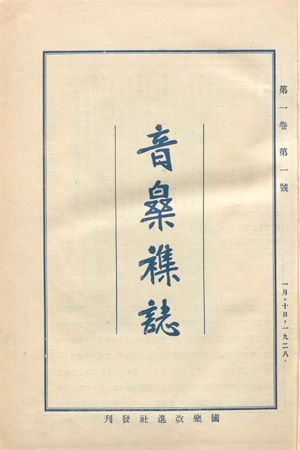Yin yue za zhi = 音樂雜誌
Prepared by Shuang Wang 王双
Online only (2023)

Yin yue za zhi = 音樂襍誌 (Music Magazine; RIPM code CMM) was published by the Association for the Advancement of Chinese Music 國樂改進社 (AACM) between 1928-1932 in Peking (Beijing). Initially intended as a monthly journal, after three issues it appeared less regularly due to a lack of funds, finally ceasing with issue number 10 in February 1932. The magazine’s English title “Music Magazine” can be found on the back cover to correspond to its Chinese title on the front cover. The journal appeared during the period mainland China was ruled by the government of the Republic of China, a democratic republic founded in 1912. Inspired by the New Culture Movement 新文化運動 starting from 1915, many scholarly publications began to appear which introduced, discussed, and debated knowledge and trends in the social sciences, arts, and humanities. These publications emerged in metropolitan areas like Peking and Shanghai, where Yin yue za zhi mainly circulated. Music connoisseurs, teachers, students, and cultural reformers at that time were the main audience of this journal.
Although China in the late 1920s was a republic, foreign aggression (e.g. the Mukden Incident, 1931) and local division (e.g. the Warlord Era, 1916-1928 and the First Civil War, 1927-1937) were causing great turmoil. Yin yue za zhi’s initial appearance reflects this, when the only music departments in Peking—Peking University 北京大學, China Women's University 北京女子大學, and National Peking Art College 藝術專門學校—suspended their programs due to unstable funding and teaching resources during wartime. Former professors and students in these programs, some of whom would become members of the AACM, began to rebuild music educational approaches when they moved to Shanghai and established a new conservatory[1] and published articles in journals such as Yin yue za zhi.
Founded in Peking in May 1927, the AACM was a society dedicated to collect, organize, and study domestic and foreign music cultures and theories. It created Yin yue za zhi to publish members’ works and public submissions under personal supports by the founder, editors, and friends. The members, including the chief editor Cheng Zhuxi 程朱溪, the founder Liu Tianhua 劉天華, and members Ke Zhenghe 柯政和, Wu Bochao 吳伯超, and Zhang Youhe 張友鶴 are the main contributors to the articles and musical scores. The journal also includes contents from other recognized musicologists, musicians, scholars such as Deng Yingsun 鄧穎孫, Hu Hulu 胡瓠蘆, Liu Fu 劉復, Miu Tianrui 繆天瑞, Xiao Shuxian 蕭淑嫻, Xiao Youmei 蕭友梅, Yang Zhongzi 楊仲子, Yuan Tongli 袁同禮, and Zhao Yuanren 趙元任. Notably, it also collects early writings from Wang Guangqi 王光祈 and Yang Yinliu 楊蔭瀏, who later became key figures in Chinese musicology.
The ten issues include topical introductions, reviews, translated articles, bibliographies of Western music, including information on and anecdotes of composers (e.g. Franz Schubert, Ludwig van Beethoven, Alexander Scriabin, and Frédéric Chopin), music genres (including some articles dealing with American jazz music), famous works (e.g. Erlkönig and Three Military Marches by Schubert, Carmen by Georges Bizet, Carnaval, Op. 9 by Robert Schumann), and concepts of music theories such as harmony, counterpoint, form analysis, and part-writing.
The journal also discusses aspects of Chinese music extensively, from reviewing recent concerts and musical movements to analyzing Chinese music history, ancient music monographs, and instruments. Two of the most substantial articles are “A Introduction to Learning Guqin” “學琴淺說” by Zhang Youhe 張友鶴 serialized in nine installments throughout the entire volume[2] and “Records of Musical Instruments” “樂家錄”:[3] Volume 11 Bili 篳篥and Volume 12 Flute 橫笛 (excerpts) by Abe Suehisa 安倍季尙 published from issue 6 to 10.
From documenting and comparing Chinese and Western music, Yin yue za zhi also features critiques and proposals for advancing Chinese music compositions by referencing Western techniques on Chinese instrumental and vocal music. To support this, included were score submissions from professional composers and music students applying innovative methods. Yin yue za zhi contains scores of solo vocal, chorus, western chamber music, piano, Chinese instrumental solo and ensemble in four different notation systems: staff notation, numbered notation, Gongche notation 工尺譜, and Jianzi notation 減字譜. The most noteworthy pieces are the Erhu 二胡 and Pipa 琵琶 works composed by Liu Tianhua, including those for the Erhu: Moon Night 月夜, Beautiful Evening 良宵, Recitation of Leisure 閑居吟, Soliloquy of a Convalescent 病中吟, Towards Brightness 明行; and for the Pipa: Improved Etude 改進操, Sound of Emptiness 虛籟, Dance Prelude 歌舞引, recorded in the journal in both staff notation and Gongche notation.[4] The founder Liu Tianhua is regarded as one of the most important musicians, musicologists, and reformers for Chinese music and instruments in twentieth century. Many of his contributions to the field are demonstrated in Yin yue za zhi as it contains many of his original articles and music scores.
The page design of Yin yue za zhi demonstrates a transitional style during the early twentieth century, as the classical Chinese (文言文, read vertically from right to left) and written vernacular Chinese (白話文, read horizontally from left to right) both appear in it. Therefore, the journal can be read starting from both ends—the front cover or the back cover—reflecting the two different writing styles, with the reader switching in the middle. The advertisements document the popular music-related products of 1920s to 1930s in China, such as music monographs, journals, record players, records, and scores.
This RIPM Index was prepared from a copy of the journal held by Cornell University.
[1] Later known as The National Conservatory of Music 國立音樂專科學校.
[2] Issue 7 reprinted the same portion found in issue 6 in order to correct excessive typographical errors.
[3] Originally written in Japan in 1690.
[4] Chinese titles of Liu Tianhua’s compositions translated into English by Wei Zhongle 衛仲樂.
